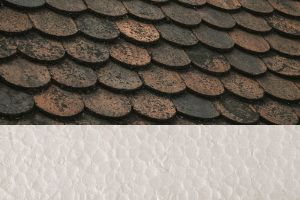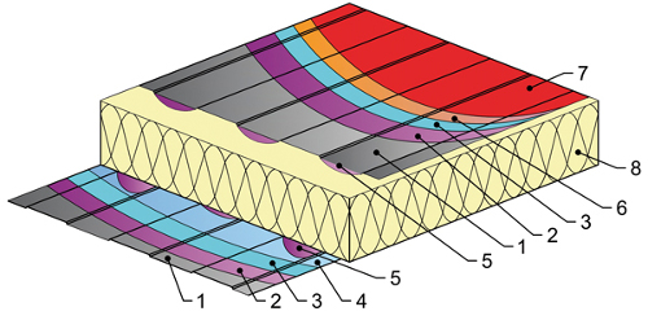Polyurethane adhesives are definitely a milestone in the construction industry. They are used as a primer in the production of sandwich panels, whose core may be made of foamed polystyrene, polyurethane, or mineral wool. Let’s see what sandwich panels are and how important it is to choose the correct adhesive.

Sandwich panels are a growing trend in the construction industry. They are mostly used in the construction of halls, industrial structures, and civic buildings, e.g. sports halls or shopping centres. They can function as roof and wall cladding. They are also used in the construction of cold rooms (e.g. small or mobile cold rooms), acting as a layer of thermal insulation. A variety of structures can be built using these panels, as it is possible to assemble them in a vertical or horizontal position and shape them according to specific needs.
Structure and production of sandwich panels
Production of wall sandwich panels is one of the newest technologies. These panels are made up of claddings and a construction–isolation core. During the production process, a polyurethane adhesive is used to join the core and the cladding. It is becoming more common to join a few insulation sheets in the process of milling. The core of the panel is made of materials such as polyurethane foam, mineral wool, expanded or extruded polystyrene, and others. Below you can find an example of a sandwich panel structure. Regardless of its intended use, properties, or manufacturer, such a panel with steel cladding should consist of:
- two steel sheets of any profile that constitute external cladding and determine the appearance of the panel and its functionality, especially in terms of construction;
- an internal thermal insulation layer ensuring correct thermal and acoustic insulation parameters and maintaining correct distance from the cladding, appropriate for the forces working within the system.
The PN-EN 14509:2013-12 standard, “Self-supporting metal-faced insulating and construction sandwich panels. Factory-made products. Specifications.” states, that a product with such structure can constitute a self-supporting construction element.

Fig. 1 Example of a sandwich panel structure: 1 – steel core of the sheet, 2 – zinc coating, 3 – passivation layer, 4 – protective varnish, 5 – adhesive, 6 – prime coat, 7 – decorative surface layer, 8 – thermal insulation material core. http://www.inzynierbudownictwa.pl/technika,materialy_i_technologie,artykul,lekkie_pokrycia_z_plyt_warstwowych,9890
Polyurethane adhesives
For panels to function correctly, it is crucial to choose the correct polyurethane adhesive. The main application advantages that the adhesives should have are: properties that ensure a quick and lasting connection of the cladding and the core, high adhesive strength, universal suitability to the joined material, vibration resistance, and excellent adherence to surface. These adhesives are elastic, but also very strong, which makes them extremely durable.
Manufacturers’ offer
Additionally, as a manufacturer of performance chemicals, the PCC Group offers two-component and one-component polyurethane adhesives. One example of a two-component adhesive is Ekoprodur 1331B2. It stands out as an adhesive for foamed polystyrene wall sandwich panels, but also for panels with mineral wool or polyurethane core. It is worth noting that it has a reduced level of volatile organic compounds (VOC) emission, as it does not contain foaming agents that significantly deplete the ozone layer. The RokaPur PR2K 105 K and Ekoprodur KW1 two-component adhesives are also available.
The product range includes Ekoprodur KW-A2 (a polyol component) and EKOPROMER G20, components of a two-component polyurethane adhesive. EKOPROMER G20 can also be applied on its own, as a one-component adhesive used in construction. It joins construction materials permanently and has excellent adherence properties.
EKOPRODUR RB-2 is one of the one-component adhesives for foamed polystyrene panels or fibreboards that can be joined with, for instance, steel sheets. It is a prepolymer based on diphenylmethane diisocyanate (MDI). It stands out due to its versatility, easy use and can be applied by hand, e.g. with a trowel, as well as mechanically. It has a broad range of temperature tolerance during use, and excellent adherence to surfaces made of various materials. RokaPur PR1K_15 (a one-component primer for sandwich plates) is another one-component adhesive in the range.
A wide range of polyurethane adhesives is available, and each of them has unique properties that make it suitable for specific applications. The key role of these adhesives, however, is their use in the construction of sandwich panels, which is the direction of the future in the construction industry.
- http://inzynierbudownictwa.pl/lekkie-pokrycia-z-plyt-warstwowych/
- https://www.sciencedirect.com/science/article/abs/pii/B9781845694357500031
- https://fastenerandfixing.com/products-plus-tools/pros-and-cons-of-polyurethane-adhesives/
